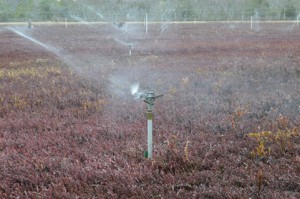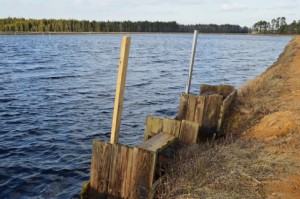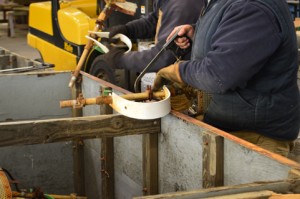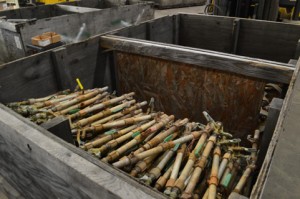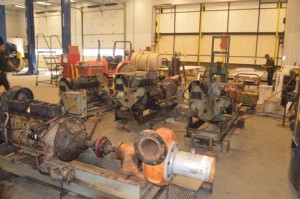A good irrigation plan manages the volume, frequency, and application of water in an organized and efficient way. A clean abundant water supply is only the first step in Pine Island’s water management program; a detailed irrigation routine is also crucial to our goals. A cranberry crop’s needs are met in three ways: rain, irrigation, and soil contribution. Unfortunately, farmers have yet to find a way to control the weather, so they must turn to the things that they can control.
Now that the winter flood is on, our team has begun working on an irrigation refurb. “A few years back we realized not everything was working optimally,” says Jeremy Fenstermaker. “So we started testing the irrigation systems–pumps, nozzles, sprinkler heads, everything–to find out why they weren’t running the right way. Then we made a plan to get everything back up to speed over the next five years.” Jeremy, along with Mike Haines, took some time to review all of our systems and then formed a plan. “Irrigation is the only thing you have 100% control over, so it needs to be done right,” explains Jeremy. “We started out checking the pressure and flow. We knew how many gallons per minute were ideal, and if a system wasn’t reaching that we took the worst ones and decided what needed to be done.”
Part of the issue is uniformity. “There are three different spacings, which means at least three different sizes of nozzles,” Jeremy says. “So it’s a priority to get everything uniform on one system. If nozzles get mixed up, it can screw up the application rate, so we’re trying to get it to where it should be and keep it that way to improve both fertilizer application and frost control. One of the big reasons we’re doing this is that we found out with different spacings there are different rates that water goes on; we want to match it at the rate the soil can take it in, but we were exceeding it in a lot of areas. If the soil is too wet, that can lead to rot. Fixing the flow won’t to eliminate disease, but should hopefully cut it down. When everything is putting water out at same rate, we don’t have to worry about water at different times. The whole farm can run at once.” And since the bogs are flooded, this is a great winter project. It’s a whole lot easier when all the sprinklers from one system are in one box; you can put your hands on all of them.
While Jeremy is working on application rates and while Waldemar Blanco and Bob Heritage are working on refurbishing sprinklers, our Equipment/Facilities team is working on the pumps. “We have a number of engines that we weren’t happy with how they were running this past season, and since the work that needs to be done is considerable, we didn’t want to do it during the season itself,” says Equipment/Facilities manager Louis Cantafio. “We currently have seven systems in here with some issues that needed addressing, and while they’re in here we’re making some adjustments that will be useful going forward. In addition to the repairs, we’re getting them ready for automation as well as making some changes that will be more efficient for the team during frost, during the winter flood, during fertilizer application…anything that could make things better for both the equipment and the team. That’s not the main reason we brought them in, but we’re taking the opportunity to update while the bogs are still under water!”

